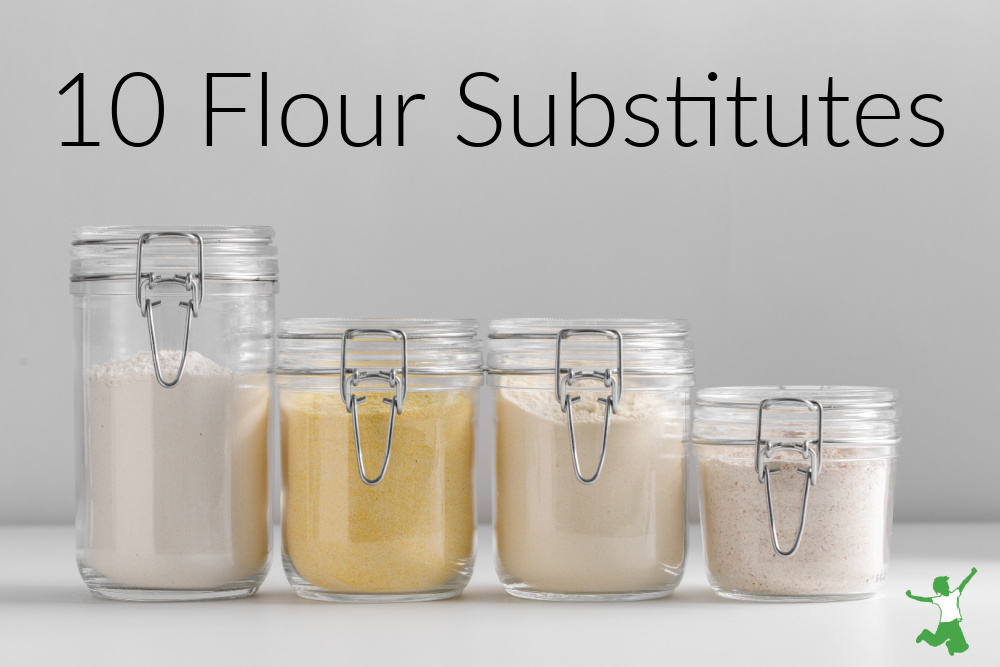Ten healthy flour alternatives to commercial versions to utilize and substitute as necessary due to dietary needs, food inflation, or grain shortages.

Food inflation is a big issue these days with no end in sight to the regular price hikes.
In addition, grain shortages are developing in some areas of the world which are making flour a scarce commodity during certain seasons of the year.
Hence, I thought I would devote this article to healthy flour alternatives I’ve used over the years that are delicious, healthy, and fun to bake with instead of more conventional choices at the supermarket.
I suggest trying them one at a time in a recipe or two…I’ve provided suggestions for each alternative below.
As a bonus, all of these flour substitutes are gluten-free too.
Based on your results and your family’s receptiveness, consider having some of these options at the ready should your regular or preferred flour choices become unaffordable or worse….unavailable due to growing shortages of grain worldwide.
With regard to appliances, I recommend an inexpensive coffee grinder (this is the one I use) and a food processor (I use a Vitamix) to process these flour alternatives instead of a conventional grain grinder.
Banana Flour
Green banana flour is appealing from a culinary perspective as it involves minimal steps and cost.
All you have to do is gather unripe green bananas before the sugar content has fully developed.
Then, peel, slice, dry, and grind.
If you have banana trees available (they are everywhere where I live), bunches of green finger bananas are plentiful and potentially free to gather.
Here is my homemade banana flour recipe to try. This type of flour substitute is one of the best forms of resistant starch that is a powerful prebiotic for the gut.
This recipe for green banana flour muffins is an easy one to try first. You can also add a scoop to your favorite smoothie recipes for an extra filling nutritional boost.
Plantain Flour
Plantain flour is very similar to green banana flour in texture, taste and nutrition.
Depending on where you live, it might be a more affordable and easily sourced choice.
Making homemade plantain flour is optimal as buying it is quite expensive at least in my area.
My favorite recipes to enjoy with this alternative flour are plantain biscuits and plantain waffles.
Note that you can substitute banana flour for either of these recipes if desired.
Cassava Flour
I’ve got a number of yuca bushes growing right now in my garden, so I intend to use a lot of cassava flour in the coming months!
Flour made from cassava root is mild tasting and an easy substitute for flour in just about any dish.
If you are cooking with this flour for the first time, try this recipe for cassava waffles. Our family loves it!
Arrowroot
Arrowroot flour looks and tastes much like cassava.
However, in the kitchen, it is best used in small amounts as a grain and gluten-free binder and thickener.
This is because making arrowroot flour yourself is a time-consuming and impractical process.
Thus, if you wish to try it, look to stock up when it is on sale and keep small amounts in tightly sealed containers in the pantry. Use up within a year, as its effectiveness as a thickener wanes over time.
One of my favorite ways to use arrowroot is in homemade vanilla ice cream.
Chickpea Flour
When it comes to legumes, chickpea or garbanzo bean flour is my favorite.
The only downside is that you will need to soak and dehydrate the chickpeas before grinding as they are high in anti-nutrients. Be sure to discard the unhealthy “aquafaba” soaking water.
If you process the chickpeas in large batches and freeze what you won’t use right away, then this method becomes more practical to consider.
My favorite use for coarsely ground chickpeas is this recipe for healthy veggie burgers.
Almond Flour
Almonds are not that cheap for most of us, but if you are fortunate to have them available locally, making homemade almond flour can be an excellent idea for baking and cooking.
My favorite recipes for nut-based alternative flour are keto bagels, almond flour pancakes, and almond flour pizza crust.
Coconut Flour
Coconut flour is used in small amounts because it is so fibrous. It makes an ideal flour substitute that is loaded with healthy fats too.
All you need is a bag of dehydrated coconut and a food processor and you are good to go!
This is my method for making homemade coconut flour if you prefer the DIY route.
My favorite recipes to try are these lemon poppyseed muffins and coconut flour pizza crust.
Potato Flour
Potato flour is made by cooking, dehydrating, and then grinding whole potatoes.
You can use almost any type of potato, hence, it makes sense to use what is most easily available and affordable locally.
Note that potato starch is different from flour. To make it, manufacturers isolate the starch portion from the potato. This is impractical to do at home.
By comparison, potato flour is a whole food easily made yourself. It can be used as a thickener in a variety of dishes instead of grain-based versions.
Perhaps the best use for potato flour is to make a basic and frugal soup. Simply blend potato flour with milk, water, and broth (or desired combination) to desired thickness and add chopped vegetables with sea salt and pepper to taste.
Acorn Flour
Flour made from soaked and dehydrated acorns is by far the most inexpensive alternative on this list.
This is because acorns for the numerous variety of oak trees are plentiful in many areas of the world and free to forage and gather in many cases!
Once you’ve made acorn flour, the sky’s the limit on how to use it in the kitchen.
Acorn mash, bread, acorn waffles, pancakes, and muffins are all options using mild-tasting acorn flour alone or in combination with others to suit your taste buds and budget.
Tiger Nut Flour
Tiger nuts aren’t easily sourced where I live, but depending on your area of the world, they might be an excellent buy!
Places where tiger nuts are commonly found include Southern Europe, Africa, Madagascar, the Middle East, and India.
If you find them on sale or at an otherwise excellent price, my suggestion is to stock up, store them in food-grade buckets with tight sealing gamma lids, and coarsely grind them as needed.
Then, combine the tiger nut flour with dates to make a paste as traditionally enjoyed. Another option is to lightly toast the nuts with sea salt to add extra flavor and digestibility, adding raw honey after roasting.
Bonus! Since tiger nuts aren’t true nuts and are low in anti-nutrients, you don’t need to soak them before grinding.
Some health sources term tiger nuts as a superfood. I would say that is stretching it, but there is no doubt that they are a nutritious alternative to conventional whole wheat and pastry flours.
What type of alternative flour have you tried in your home? Please add to this list in the comments section with recipe suggestions you’ve enjoyed!









I found a website for lectin free food recipes! She is soaking her coconut flour! I tried it in my gluten free bread which I have been making with unsoaked flour! I was able to add less eggs! I am going to make crackers and pizza because soaking makes much more batter! So interesting!